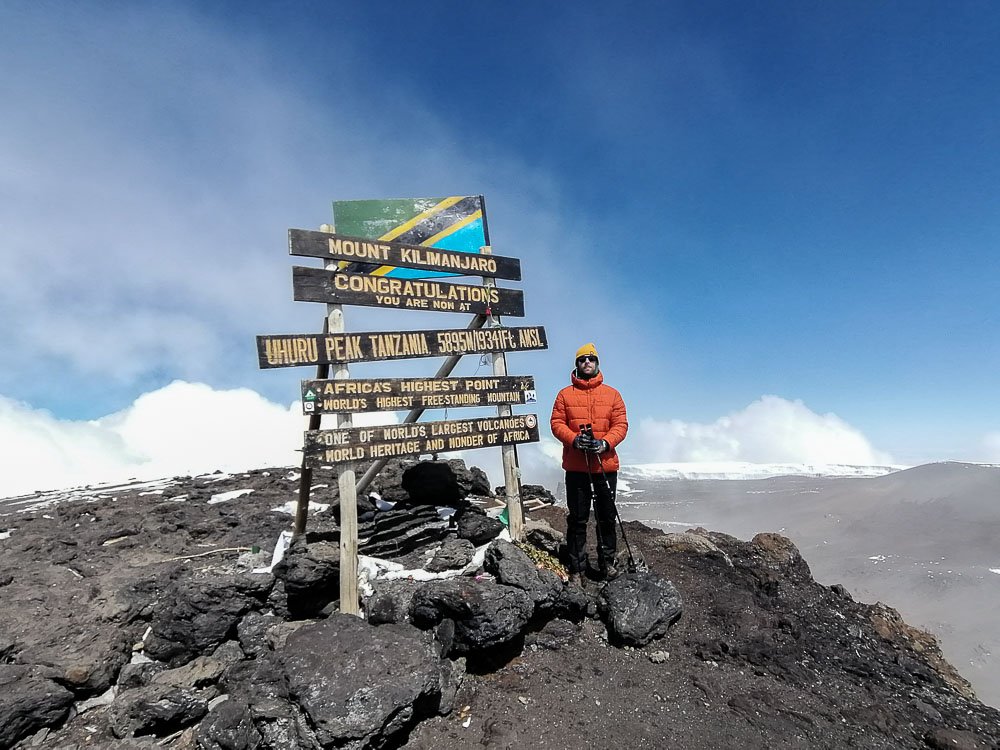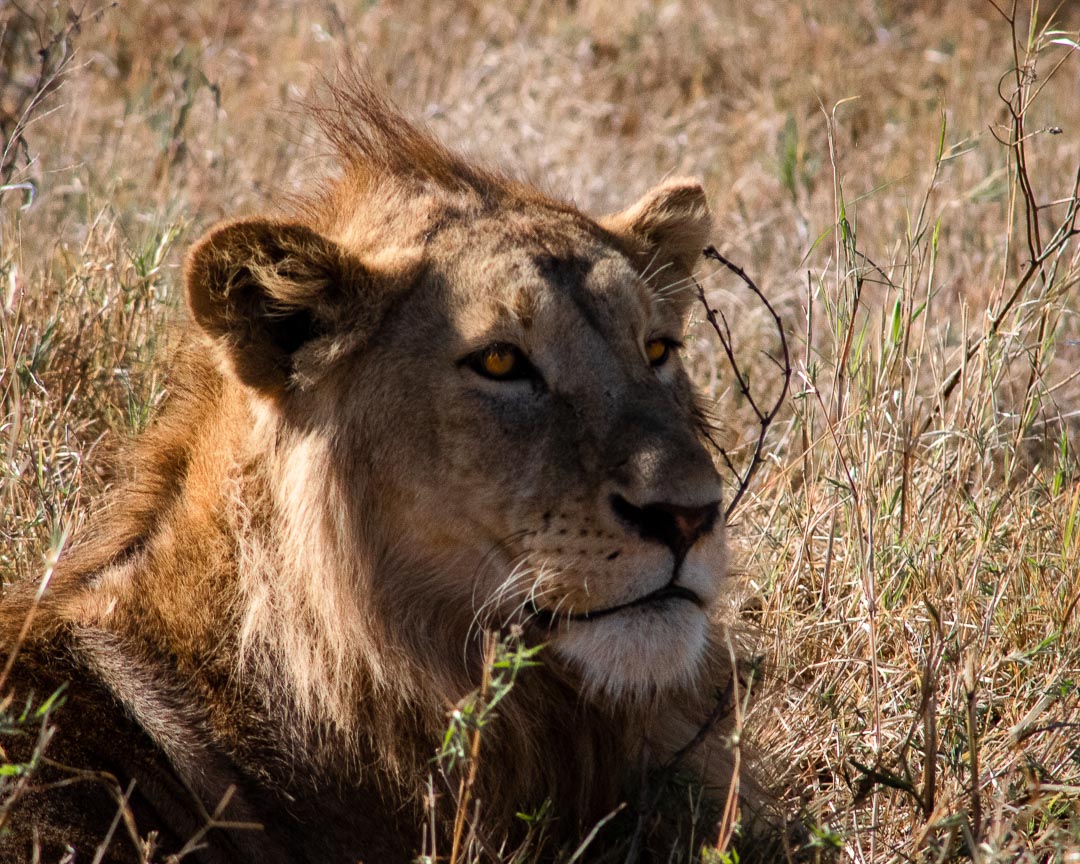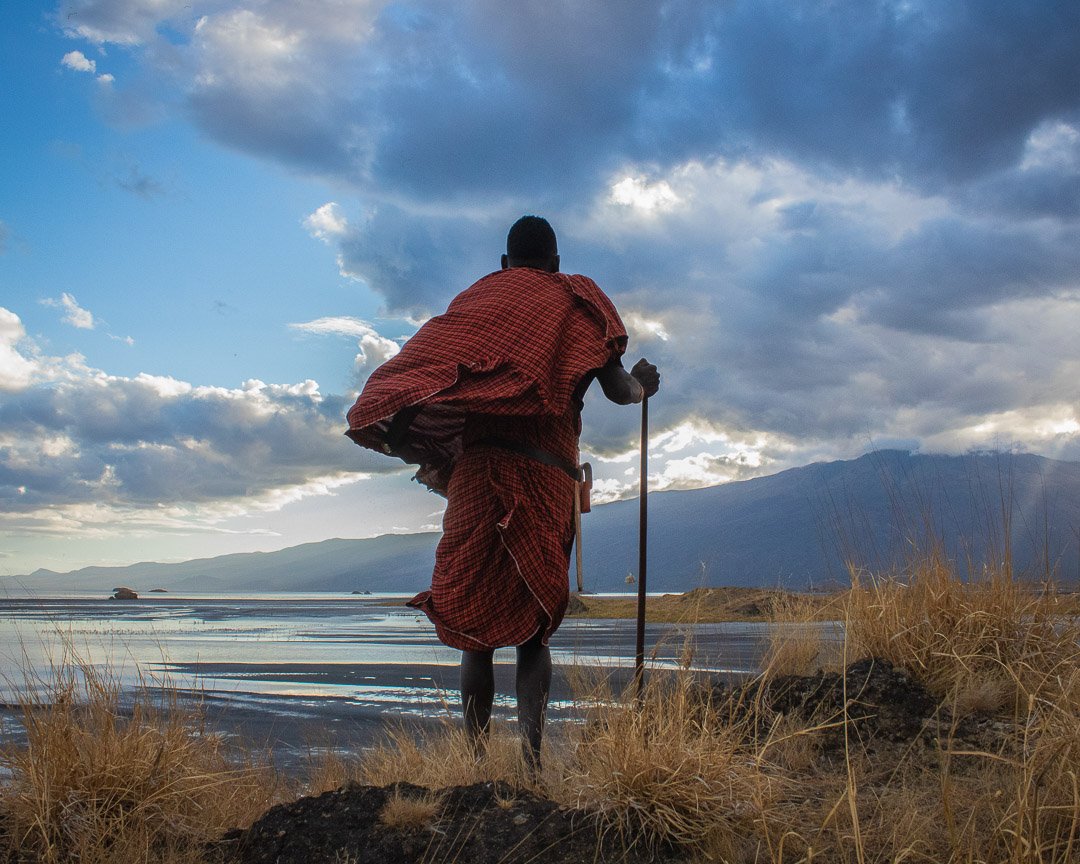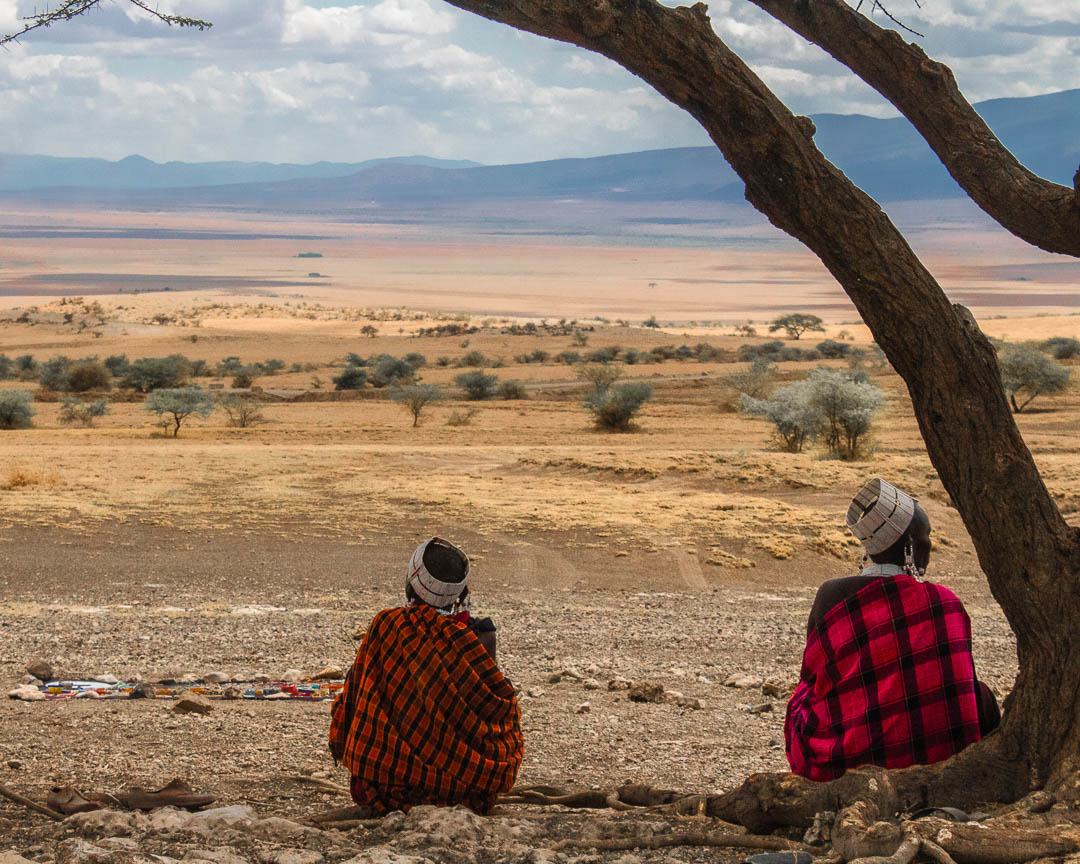When people think of Tanzania, often it is of Mt. Kilimanjaro mountain climbing, wildlife and of the many tribal cultures. Tanzania and adventure go hand in hand, so in this guide for adventure activities in Tanzania we shall explore even further to help you build the perfect itinerary for your stay!
Mountain Climbing in Tanzania
Climbing Mt. Kilimanjaro
Let’s start with the big one: hiking Mt. Kilimanjaro. Kilimanjaro is the tallest mountain in all of the African continent. It is also the tallest free standing mountain in the entire world. This is because most mountains are part of a range, where there are many peaks all forced into the sky from tectonic plates pushing towards one another. Kilimanjaro is formed from a volcano which first erupted around 2.5 million years ago. The eruptions have left Kilimanjaro with 3 separate cones: Shira, Mawenzi and Uhuru. Uhuru is the tallest, with the highest peak being 5,895m (19,341ft) and is dormant – meaning it could still erupt one day.
There are 7 different routes for climbing Kilimanjaro. They vary in difficulty, time, cost and personal preference.
Marangu route is the only one that offers hut accommodation and is very popular. It is also the only route that takes an ‘out and back’ approach, i.e. the same path up and down. Although it is thought to be easier than the others, I would still veer clear from labelling any hike up Kilimanjaro as ‘easy’.
The Marangu route can be attempted in the least amount of days, just 4 nights and 5 days. This makes it appealing for budget conscious tourists who can also save money by not bringing extra camping gear and extra porters. The quick ascend can make proper acclimatisation more challenging. The route is stunning and with the right mental attitude and preparation can still be accomplished.
The Machame Route is the second most popular route and is a camping option. It’s physically more difficult and strenuous, with lots of ups and downs as you traverse the valleys. A breathtaking route with the Lava Tower, Barranco Wall and some steep scrambles.
When booking a Mt Kilimanjaro hike, you will be flooded with options and a huge range in price. I will always whole heartedly recommend doing your research on the provider. It can be tempting to see the cheapest option and go with that, but you will get what you pay for. When venturing into the wilderness to take on any extreme adventure, paying for expertise, good gear and professional, safety focussed guides will pay off dividends. Your experience will be massively enhanced as all your needs are taken care of and you are able to enjoy the process without stress.
Follow this link for more information on the Global Shenanigans Expeditions to Kilimanjaro! We organise group tours that include a safari every year, as well as private options too. Or check out the Ultimate Kilimanjaro Guide: Everything You Need to Know Before You Go!

Hiking Mt. Meru
Meru is the second highest mountain in Tanzania at 4,562m (14,968 ft) and is also a still dormant volcano. The last minor eruption was in 1920. Climbing Mt Meru is an epic adventure activity in Tanzania as it combines both mountain climbing and safari.
It’s located in the Arusha National Park. On your drive in you may well see elephants, giraffe and zebra. My guide also told me he has seen lions whilst walking on foot during the first section of the climb!
Although Meru is lower elevation than Kilimanjaro, that doesn’t mean it is any easier. In fact the climb is technically more difficult and challenging. But you are less likely to face altitude sickness. Many people like to climb both mountains in the same trip, using Meru as an acclimatisation hike before taking on Kilimanjaro.
However you decide to approach, it is a highly recommended mountain climb and allows for the pairing of hiking and safari quite easily.
Safari in Tanzania – The Best Safari Parks
Visit the Serengeti National Park
I’ve started with the Serengeti because it’s the most famous. It is one part of the larger Serengeti Ecosystem that also covers the Ngorongoro Conservation Area and the Maasai Mara in Kenya. A wildlife safari in the Serengeti will give you the opportunity of ticking all of the boxes you’d hope for with wildlife encounters in Tanzania.
Home to big cat predators such as lion, cheetah, serval and leopard; elephants, giraffes, honey badger and the super rare pangolin. The Serengeti National Park is also on the path of the world famous Great Migration of wildebeest and zebra.
The Serengeti offers accommodation to every budget within the grounds of the National Park. There are luxury lodges with beautiful poolside vistas, as well as bare bones camping. I opted for 3 nights camping to feel as close to the wildlife as possible. And ohhh were we close! Hyenas were moving amongst the shadows of the campsite one evening, and the next night I went to sleep to the sounds of lions roaring. Some people might be freaked out by this, but it was a highlight experience for me.
Another incredible way to experience the Serengeti would be with a sunrise hot air balloon ride. You’ll be able to see wildlife from a position few get to see, as you effortlessly float above the earth as the animals go about their mornings.
The word ‘Serengeti’ means ‘endless plains’ in the Maasai language. All the way to the horizon, as far as the eye can see, is dirt and shrub. A true savannah. The sporadic trees can be few and far between. The reason for this is due to the eruption from Ngorongoro some 2-3 million years ago. Larva spewed and flowed over the land before turning to solid rock. This rock is not so deep underground, meaning most plants and trees cannot survive here as they are unable to lay deep roots.
The environment is fascinating and I would 100% recommend a visit to the Serengeti National Park if your schedule allows. The only downside is that it is further to get to from the main towns in comparison to other parks.

Experience Ngorongoro Conservation Area Safari Adventure
The Ngorongoro Crater is a truly breathtaking geological wonder and is the centrepiece of the Ngorongoro Conservation Area. As mentioned before, the eruption that took place 2-3 million years ago shaped the surrounding area and left behind the worlds largest inactive volcanic caldera. The eruption caused the volcano to collapse in on itself. The crater is 610m (2,000ft) deep and the floor covers 260 sq kms (100 sq miles).
The area lies in a special category of protection in Tanzania, where Maasai pastoralists are allowed to live. The settlements are along the outer crater, but the Maasai people do bring their cattle into the centre to drink from the lake once or twice a week. It’s thought that the water provides key nutrients in keeping their cattle healthy. The careful coexistence between the people and wildlife is due to the fact that the Maasai do not hunt or eat any of the wild animals as they have cattle and goats.

Adventure Activity in Tarangire National Park
The Tarangire National Park is a great option for visitors arriving in Moshi. It can be linked together with Ngorongoro and Lake Manyara to make a varied 3 days safari itinerary, finding accommodation in the centre of all three. The park is named after the Tarangire River that runs through it – be sure to check out the view point picnic area overlooking it but watch out for the raiding monkeys!
Tarangire is best known for its high number of elephants and baobab trees (also known as upside down trees), and there is apparently a super rare white giraffe living there! Although elephants are main attraction, there is always still a chance of seeing lions and the other usual suspects.

Safari to Lake Manyara
Lake Manyara is a surprisingly vegetated area with jungle, water and impressive views of the Rift Valley. Water run-offs flow from the Ngorongoro Highlands, along underground rivers and sprouting in springs. These feed the forest and create dense jungle sections, perfect for blue monkeys (the leopards favourite food).
The lake has no outflow, so when the heavy rains come the banks tend to swell and swallow the safari tracks. In the dry season the lake will shrink. The shrinking can lead to better wildlife viewing as there are less places for the animals to drink from.
One of the most famous attractions of Lake Manyara are the tree climbing lions. It is unknown whether this is a new lion behaviour or if humans have only just started to witness it. There are a few theories of why they do it. The temperature is cooler at height, with some breeze and shade under the canopy. The tree tops provide a better view point for hunting prey and finally, cats don’t like water so will prefer to sit in the tree than on the damp grass. Whatever the reason, it makes for an incredible sight and has led Lake Manyara to lay claim to ‘Home of the Tree Climbing Lions’.

Birdwatching at Lake Natron
Home of the Greater and Lesser Flamingoes!
Roughly 75% of the world’s lesser flamingos are born here and is used as a breeding ground by 2.5 million individuals. High toxicity levels in the water help keep predators at bay and the birds safe. With a ph level of 12 alkaline and temperature of 40-60c, it’s no surprise!
Lake Natron is a protected conservation area, rather than a National Park. This distinction means that Maasai people are able to live in this area and own or run the accommodation too.
If you wanted further proof of Lake Natron being an epic choice for an adventure break in Tanzania – it was featured in an episode of Perfect Planet by David Attenborough, where he explains the volcanology of this extreme environment. Give the programme a watch and you’ll be booking your trip immediately!

Witness The Great Migration
Many people who travel to Tanzania for a safari are often there to witness a specific event, rather than a location.
That event is the Great Migration.
This is the continuous movement of millions of wildebeest and zebra across the most spectacular parks in East Africa, in a never-ending cycle of awesomeness.
There is no start or end, but rather a fluid movement of animals in the most mind boggling of numbers. The timing and location is affected by rain, drought, food supply, mating and birthing. December to March is calving season for the wildebeest in the Serengeti and Ngorongoro border. The grass is rich in nutrients from the volcanic eruptions in this area, which in turn leads to the best milk for the calves. The lions take advantage of the abundance of prey in the area are will be on the hunt.
As the summer continues, the migration moves north, devouring all the grass in its path. The wildebeest head towards the Grumeti River, where they now face crocodile laden pools if they wish to take a drink. They move along the Serengeti western corridor towards the Maasai Mara. By August the bulk of the migration is flooding into the Maasai Mara, where traffic jams can turn the crocodile infested river crossings into a dramatic blood bath. From September and October, the migration loops back south towards fresh pastures in Tanzania, in time for their short winter rains and beginning the cycle again.

Trekking with Chimpanzees in Mahale Mountains National Park
A little known adventure activity in Tanzania is the chimpanzee trekking. The reason it is less known is because it’s off the beaten path, over on the western side of Tanzania. Although getting there is more of a commitment than other wildlife safaris, you will not be disappointed with your decision to do so.
This distant and almost empty park is a magical experience, where a population of 1000 chimpanzees enjoy the jungle canopy. Mahale Mountains National Park has wondrous forests and white sand beaches washing the shores of Lake Tanganyika. The area is home to Jane Goodall’s research centre, where her historic 60 year study of chimpanzees completely transformed our understanding of our not so distant relatives.
Walk in Jane Goodall’s footsteps as you track the chimpanzees on an immersive safari through the jungle.
I would recommend this adventure activity for people who have already been on more traditional safaris or who have a longer itinerary. Or if you just really love chimpanzees!

Cultural Tours with Tribes in Tanzania
A Morning Hunt With the Hadzabe Tribe, Lake Eyasi
This truly is one of the most spectacular adventurous activities available in Tanzania. I have been fortunate to travel all over the world and have experienced many unique things, but nothing compares to my morning with the Hadzabe people.
The Hadzabe are an indigenous ethic group that make their home around Lake Eyasi, near to the Serengeti. They are a semi-nomadic group who follow a traditional hunter gatherer way of life. With the expansion of tourism, from pastoralists and other modernisations; their way of life is coming under threat. As other people move into their once game rich territories, the wild animals the Hadzabe hunt for survival will become more and more sparse.
Initiatives for protection are underway. The government have allocated land for the Hadzabe people to roam and hunt, and more importantly to keep others out. At the same time, allowing a limited number of tourists to join the Hadzabe for their daily activities on a cultural exchange increases awareness, education and generates a further income and support. There are also NGOs under development right now with the goal of drilling for water. This will give them one less task to have to worry about, particularly in the harsh dry season. This in turn will help the Hadzabe to thrive in the bush and not just survive.
Carefully managed, community focused tourism may just be the lifeline that could allow these proud people to continue their traditional lifestyle. By educating outsiders of their culture, we too can help to preserve it.
Click here for my account from a morning spent Hunting with the Hadzabe
Hunting With the Hadzabe
Visiting a Hadzabe community is an incredibly powerful and educational experience. To learn about a different way of life, to see how they make and use tools for different purposes, as well as starting a fire with complete ease.
I headed out with Gem, a Hadzabe hunter, as he started the day with finding breakfast. He showed us the different arrow heads required for different prey. Blunted arrows for birds and arrows laced with poison for larger mammals.
What they find is what they eat. In this instance it was some small birds – which I would like to note, was an incredibly impressive shot from Gem! Other times meals can include dik-dik, kudo, porcupine, monkey or their favourite, baboon. Gem managed to shoot some birds for breakfast whilst the women showed us how to forage for potato-like roots. We headed back to the small encampment hidden in the rocks to eat. After that we tried some target practise with the bow and arrow before saying goodbye.
It’s important to be aware that the Hadzabe live a different way of life from what many people are used to. If you are uncomfortable with watching prey being killed, prepared and eaten then this is not for you.
If you would like to genuinely learn about a traditional hunter gatherer culture in the most authentic way, to join the Hadzabe people and learn about their lifestyle, then I think this is an adventure experience you will love!

Meeting the Datooga Tribe
The Datooga are a pastoralist tribe who are known for their metal working. There are Datooga communities around Manyara, Mara, Arusha and other areas. The settlements around the Lake Eyasi area allow for a simple itinerary to combine a visit to the Hadzabe people and Datooga on the same day.
The Datooga are skilled metal workers. They find brass from scrap metal – nails, screws and old car parts; and turn it into beautiful jewellery to sell either in town or to visiting tourists. They also fashion arrow heads to trade with the local Hadzabe people in exchange for honey.
I had a fascinating experience of cultural exchange when visiting the Datooga. Sitting with the women of the village with the guide as interpreter, we asked questions back and forth about life here for them, and life back home in the U.K. for me. It was intriguing to discuss different family structures, communities and opportunities.

Trekking with the Maasai
The Maasai are the largest and most well known tribe, living around many parts of Tanzania and Kenya. Many Maasai people still practise their traditional semi-nomadic, pastoralist ways. They herd cattle, goats and Maasai women craft beautiful jewellery.
The Maasai people of Tanzania and Kenya welcome visitors to their communities to educate about their culture, traditions and history. The money generated from this brings with it greater and new opportunities for the people, to either make their own lives more comfortable or to further their education in the cities.
As the Maasai numbers are so large in comparison to other tribes, it can be fairly easy to find a community near to other areas that you are wishing to visit. However, if you really want to take part in a true adventure activity in Tanzania, then I suggest a Maasai Trek.
The Maasai Trek activity is a multi-day hike towards Lake Natron. This stunning walking route will take you passed numerous Maasai villages, as we skirt along the ever imposing Great Rift Valley. We’ll be camping under the stars, experiencing Tanzania in a way that not many have ever done before. Along the route we will likely see zebras, giraffe, gazelle and other wild animals. The trek is accompanied by a support vehicle that carries camping gear and supplies. You will not find many organisations offering this activity, so if you would like to do something really special, do get in touch. My team and I would love to make this experience happen for you!

Visiting the Chagga Caves
The Chagga tribe are the people who live on and near to Mt Kilimanjaro. The higher elevation has allowed them to grow more fruit than their neighbouring pastoralist tribes, as well as keep chickens and pigs. This supply of food has led to a great deal of devastating conflict over the years, particularly between the Chagga and Maasai. When there is a drought or a bad season, the lowlanders start to venture up the mountain. They form raiding parties that would attack the Chagga for food.
The Chagga people were lower in number than the Maasai. They also couldn’t live with the constant threat of the raids. And these raids led to unimaginable brutality from both sides. Over time the Chagga started to dig tunnels. The tunnels began under the floor of their houses and linked up with the rest of the community, with some running almost 5kms. They used a number of incredibly smart techniques to keep themselves protected, such as blocking light from leaving, disguising the smoke of their fires and ways to identify if a person entering the tunnel was friend or foe.
The tunnels were large enough for 100s of people to live in for months at a time, with secret passages for warriors to leave and to dump the bodies of anyone who dared to enter uninvited.
Visiting the Chagga Caves is an important part of visiting the Kilimanjaro region. It is the history of the people whose ancestors lived amongst the hillsides and is a part of the story of Tanzania.
This conflict amongst cultures only recently subsided when the tribes of Tanzania unified as one independent country in 1963.
Adventure Activities in Tanzania Close to Moshi
Do Go Chasing Chasing Waterfalls!
Mt Kilimanjaro has many river run offs, and a lot of these lead into incredible waterfalls and bathing pools as they make their way down the mountain. The water is definitely fresh!
I checked out the Materuni waterfall after the coffee tour (I’ll get to that next) which was spectacular. This mass of water cascades down the cliff face, with a fairly large swimming area at the bottom which I feel that could get quite busy in the peak season. Along the way down are a few locals ‘bars’ – I’d recommend picking up a banana beer or banana wine on your way passed.

The Coffee Plantation Experience
A morning spent with the coffee boys is a morning well spent! These chirpy lads are really into their coffee. They were all local to the area and spent their time working on the coffee plantation and creating gifts and trinkets for tourists to pick up as souvenirs.
The first stage of the coffee tour near Moshi is to walk around and check out the plants. The mountain side elevation creates a moist and humid climate – perfect for plants to grow. After the walk-around they showed me some beans that were harvested earlier. They would be dried, then crushed, sieved and crushed some more. You can take part in the whole process which is really fun. As you crush or sieve, the coffee boys would break into song. They say that singing helps them to keep their mind off the work.
After the beans have been ground to a fine powder, they are put into the water and boiled. You can then enjoy a lovely cuppa with the boys with a chance to purchase your own bag to take home.

Swimming in Chemka Natural Hot Springs
Taking a dip in the Chemka Hot Spring is the perfect addition to an adventurous trip to Tanzania. The oasis like bathing area is creating from water that runs all the way from Kilimanjaro. It runs along an underground water table and eventually breaks the surface in this area. All the land around it is barren and dusty. But the natural spring has led to an explosion of vegetation. The crystal clear water flows through a larger open area which has a rope swing and some trees to jump off.
The Chemka Hot Spring is located between Moshi and Arusha, so it can be a good activity to fit in when travelling between the two.

How to Book Tours for Adventure Activities in Tanzania?
This is the easy part! Every single activity included in the list can be arranged through Global Shenanigans. Some items of these adventure activities are included in the Kilimanjaro Hike & Safari Expedition where I will personally accompany you on your tour.
Or if you wish to travel on a different date, private tours can be arranged either with me or with my team based in Moshi.
If you are interested in joining us or have any questions about these activities – please do get in touch!
